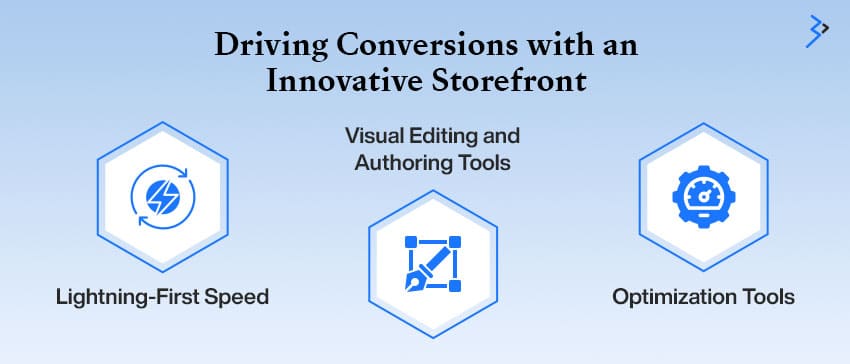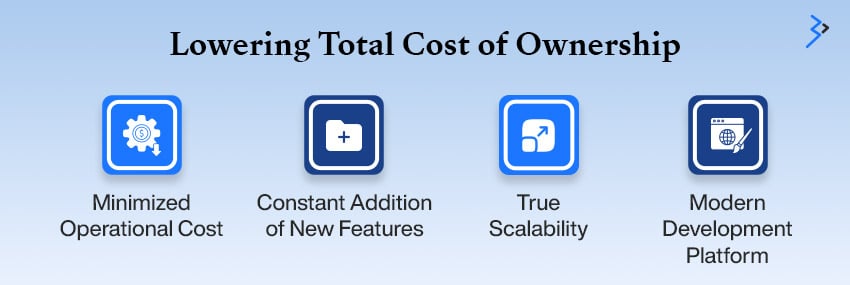The reality of running an online business in today’s modern world is the endless competition, the dynamic customer needs, and the constant need to be highly nimble. It used to come by when someone could have an online store. A business must have an eCommerce platform capable of operating at extreme scale, enabling breakneck innovation, providing unparalleled customer experience, and maintaining operational costs.
Adobe Commerce as a Cloud Service helps brands boost conversions, launch faster, and cut costs significantly. It’s a major shift in how digital commerce is handled, offering easy integration, strong performance, and the ability to scale as you grow. For new businesse,s especially, it’s a game-changer.
The Modern eCommerce Imperative: Agility, Experience, and Efficiency
Think of the challenges posed to modern digital commerce activities. Customers demand a seamless and personalized customer experience through their shopping path using a mobile phone, desktop, or even a voice assistant. They also insist on flash-fast web page loading and easy navigation.
In today’s enterprise landscape, brands need to move fast, whether it’s launching new products, responding to market trends, or expanding into new regions. But outdated technology often slows them down. On top of that, the rising costs of infrastructure, maintenance, and constant updates only add to the pressure.
Traditional eCommerce configurations, which require manual upgrading, complicated infrastructure management, and a sluggish deployment cycle, often fail to fulfill these requirements. They also serve as cost centers instead of growth engines, killing the innovation factor and affecting the bottom line. This preconditions the appearance of cloud-native architecture, such as Adobe Commerce, as a cloud service that redefines possibilities.
Introducing Adobe Commerce as a Cloud Service: The Future of Digital Commerce
Adobe Commerce as a Cloud Service is more than an update; it is a rethinking of the whole eCommerce foundation in terms of the modern, cloudy environment. It is a cloud-native, full-stack platform that provides scale and infrastructure maintenance, security, and automated updates. This fundamental change relieves organizations from the pressures of IT management and enables businesses to concentrate all their efforts on strategy, consumer involvement, and innovation.
It offers a highly performant, secure, and stable base that dynamically scales to traffic requirements, ensuring the service can never be depleted, even during the shopping season. The design of this managed service operation is based on the fundamental problems that thriving businesses have to cope with: how can we increase conversions, speed to market, and reduce costs?
Key Pillars: Driving Conversions, Accelerating Time to Market, and Lowering Costs
Adobe Commerce as a Cloud Service is a powerhouse because its design fits its capabilities best and is created to support its claims based on a number of its core pillars:
1. Accelerating Time to Market Through Cloud Agility

It is worth noting that one of this platform’s most significant benefits is its unmatched power to hasten the time to market. Cloud-native architecture has the eye-popping advantage of simplifying development and deployment cycles.
- Automated Upgrades: The automatic rollout of new features and security patches eliminates the need to upgrade and patch manually. This ensures your platform runs on the latest and most secure version, saving you valuable development time.
- Self-Service Provisioning: Businesses have the potential to provide global production and sandboxes in minutes to days and weeks. This will allow the company to experiment, test, and expand into unknown markets or launch new brands faster than ever.

- Pre-configured Services & Composable Functionality: Pre-configured commerce services must be pre-integrated to minimize setup time. Besides, they have composable functionality that allows businesses to replace, add, or extend core functionality with third-party services (such as ERPs, CRMs, search, and payment) by leveraging Adobe development accelerators. Thus, they are very adaptable and minimize complex integration projects. This agility governs the speed at which products or promotions can be rolled out.
Read More – Integrating Adobe Commerce Cloud with Adobe Experience Manager
2. Driving Conversions with an Innovative Storefront

The final result of an eCommerce site is to turn viewers into customers. Adobe Commerce as a Cloud Service is designed to achieve this through conversions by delivering a remarkable shopper experience.
- Lightning-First Speed: The platform features Innovative Storefront, powered by a layer of edge computing, leading to a blazing site speed with pages downloading lightning fast, with very high Lighthouse scores (typically 90 or higher). According to Adobe, such speed enhances search engine optimization, increases organic traffic, and directly concretizes the conversion rate, which in most cases causes a decrease in paid search expenses. The customers have more time to shop, get to see more, and do not give up their carts as easily due to slow loading time.
- Visual Editing and Authoring Tools: Visual editing and authoring tools provide merchandisers with powerful features and convenient and easy-to-use tools, allowing them to meet the challenges of immersive and personalized user experience, bypassing IT. Using generative AI development services, they can create numerous and diverse copies and images of products within a short period and, thus, accelerate the construction of content and create catchy storefronts.
- Optimization Tools: The platform integrates A/B and multivariate testing tools, as well as AI-based search and product recommendations, allowing the digital trade experience on the fly to be recomposed. The brand’s advertisement can constantly be improved so that the focus remains and is translated into purchases.
Read More – SEO Strategies to Boost Visibility on Adobe Commerce Cloud
3. Lowering Total Cost of Ownership (TCO)

Although the initial investment in a robust platform may be viewed as high, Adobe Commerce as a Cloud Service is developed to reduce expenditures in the long term by drastically reducing the Total Cost of Ownership (TCO).
- Minimized Operational Cost: Adobe is a managed service, so there is no infrastructure, security patches, or upgrades to manage. This obviates the cost of keeping a huge in-house IT staff to take care of the platform, reducing the overhead on operations.
- Constant Addition of New Features: You and your users will always have the latest updates and the newest features, and will not have to worry about doing any downstream work or spending hefty upgrade dollars.
- True Scalability: Owing to its cloud-native design, the platform can effectively scale due to its ability to handle spikes in traffic, orders, and search requests. This benefit means an organization does not need to overbuild the infrastructure to service a surge assumption; one only pays for what is used up.
- Modern Development Platform: The platform offers extensive extension opportunities and state-of-the-art developer tools to enable continuous innovation without ever gaining technical debt through legacy systems or complex custom code. This will make development much easier and less maintenance-intensive in the future.
Read More – Scaling eCommerce Success with Adobe Experience Manager and Cloud Integration
Benefits in Action: Real-World Impact
All the above theoretical advantages of Adobe Commerce as a Cloud Service translate into real profits of businesses working in different spheres. Take an example of a big retailer with massive spikes in traffic during seasonal sales, such as Black Friday. A conventional system would give in under the pressure, and there would be disappointed customers and missed sales. Its Cloud-native architecture will ensure that Adobe Commerce automatically scales as a cloud service, enabling uninterrupted customer service. This helps make the conversion even in the most strenuous times.
The platform’s new capabilities will revolutionize brands’ approaches with extensive product lines. According to Adobe, having a single instance with a manageable number of up to 250 million SKUs and 30,000 diverse price points of a SKU makes expansion of brands and business lines highly fruitful. PHD distributed architecture enables multiple locations to be updated promptly to add products or price changes using a flexible, rule-based catalog model, which enhances time to market with new products and campaigns by orders of magnitude. Moreover, it is also essential to improve the sites’ performance continuously. The quicker the site’s loading time, the better the user customer experience and the higher the search engine ranking. Businesses can maximize their organic presence by aiming to score 90 or beyond using the Lighthouse, which will decrease the need to afford heavy paid ads and assist in reducing costs.
Beyond the Platform: Strategic Partnership for Success
As much as Adobe Commerce as a Cloud Service offers an attractive starting point, the best way to utilize all the available capabilities requires the right plan, specialist deployment, and constant optimization. Putting a platform this caliber in place is more than throwing a switch; it requires advanced knowledge of digital commerce strategy, migration, integration of applied systems with existing business systems (such as ERP and CRM), and ongoing performance modifications. By getting the support of an experienced implementation specialist, you not only align the platform to your business specifics, unlock all the functionality, and make conversions, but also hasten time to market and reduce costs. They lead the process of navigating around the complexities, thus making the process smooth to run through and ensuring constant innovation.
We at Brainvire are aware of the nuances and possibilities of the reality of digital commerce. Being the experts in Adobe Commerce as a Cloud Service, we strive to use this innovative eCommerce platform to its full extent, contributing to the profitability of businesses. We offer full-service packages engineered to increase conversions by improving client experience and site performance, dramatically decreasing the market time of your innovations, and finally reducing the costs by leveraging high-performance executions in the cloud environment and streamlined operations. With our expertise, you will no longer worry about your digital commerce strategy being recyclable, scalable, and sustainable; hence, you will be able to excel in the competitive online space.
FAQs:-
It’s a full-stack, cloud-native architecture eCommerce platform where Adobe manages the infrastructure, security, and updates, allowing businesses to focus on strategy and customer experience.
It streamlines development with automated updates, self-service provisioning of environments in minutes, and pre-configured services, enabling rapid deployment of new content and functionalities.
It reduces Total Cost of Ownership (TCO) by eliminating manual upgrades and patching, providing automated scaling to avoid over-provisioning, and reducing the need for extensive in-house IT management.
It delivers an ultra-fast, high-performance storefront with excellent Lighthouse scores, offers AI-powered merchandising tools for personalization, and includes built-in optimization features like A/B testing, all contributing to a superior customer experience that boosts sales.
Yes, its cloud-native architecture is designed for scalability, capable of handling massive traffic, orders, and managing up to 250 million SKUs and 30,000 unique price points per SKU in a single instance.
Related Articles
-
Build vs. Buy: When AEM Components Outperform Custom FE Frameworks
There’s always that classic “Build vs. Buy” dilemma we all wrestle with, especially when it comes to an enterprise-grade Digital Experience Platform (DXP) like Adobe Experience Manager (AEM). Going for
-
Transforming Customer Service: Proactive and Personalized Support with Adobe Journey Optimizer
Nowadays, customers expect more than just transactions—they expect meaningful, personalized interactions at every touchpoint. Whether browsing a website, opening an email, or walking into a store, they want brands to
-
The Importance of User Experience (UX) in Hyvä Theme Development
In today’s digital landscape, where users have countless options at their fingertips, delivering an exceptional user experience (UX) is paramount. For Hyvä (High-Value Yet Accessible) theme development, prioritizing UX isn’t




